40 label encoder python example
Categorical encoding using Label-Encoding and One-Hot ... labelencoder = LabelEncoder () # Assigning numerical values and storing in another column. bridge_df ['Bridge_Types_Cat'] = labelencoder.fit_transform (bridge_df ['Bridge_Types']) bridge_df. bridge_df with categorical caolumn and label-encoded column values. Label Encoder vs One Hot Encoder in Machine Learning [2022] - upGrad blog For example, we have a dataset that has a comparison of a certain quality in a certain skill in the form of a superlative comparison between siblings. The dataset is good, better, best. After applying a label encoder each quality will be given a label 0,1,2 respectively. ... Label Encoding in Python can be implemented using the Sklearn Library ...
Guide to Encoding Categorical Values in Python - Practical Business Python Approach #2 - Label Encoding. Another approach to encoding categorical values is to use a technique called label encoding. Label encoding is simply converting each value in a column to a number. For example, the body_style column contains 5 different values. We could choose to encode it like this: convertible -> 0

Label encoder python example
python - Working of labelEncoder in sklearn - Stack Overflow In addition to the integer example you've included, consider the following example: >>> from sklearn.preprocessing import LabelEncoder >>> le = LabelEncoder () >>> >>> train = ["paris", "paris", "tokyo", "amsterdam"] >>> test = ["tokyo", "tokyo", "paris"] >>> le.fit (train).transform (test) array ( [2, 2, 1]...) Categorical Data Encoding with Sklearn LabelEncoder and ... - MLK The Sklearn Preprocessing has the module LabelEncoder () that can be used for doing label encoding. Here we first create an instance of LabelEncoder () and then apply fit_transform by passing the state column of the dataframe. In the output, we can see that the values in the state are encoded with 0,1, and 2. In [3]: Python sklearn.preprocessing.LabelEncoder() Examples Setting this to False may take a great amount of memory. :type sparse: boolean. """ self._clf = estimator self._encoder = LabelEncoder() self._vectorizer = DictVectorizer(dtype=dtype, sparse=sparse) Example 3. Project: sato Author: megagonlabs File: datasets.py License: Apache License 2.0. 6 votes.
Label encoder python example. Label Encoding in Python - Javatpoint Understanding Label Encoding. In Python Label Encoding, we need to replace the categorical value using a numerical value ranging between zero and the total number of classes minus one. For instance, if the value of the categorical variable has six different classes, we will use 0, 1, 2, 3, 4, and 5. Now, let us understand label encoding with the data of COVID-19 cases in India across states as an example. While observing the following data frame, we will find out that the State column ... Label and One-Hot Encoding in Python Label and One-Hot Encoding in Python Learning Objectives: In today's lesson, you will learn the following: Label Encoding One-Hot Encoding Code Example Label Encoding Label encoding is the conversion or transforming of labels into a numeric form so as to convert the values in the labels into the machine-readable form. it is important preprocessing step for any structured dataset in ... When to use LabelEncoder - Python Example - Data Analytics LabelEncoder Python Example Here is the Python code which transforms the label binary classes into encoding 0 and 1 using LabelEncoder. The Breast Cancer Wisconsin dataset is used for illustration purpose. The information about this dataset can be found at (Diagnostic). Ordinal label encoder of categorical variables ~ All About Python Label encoder is the most simple methodology, which convert the categorical values into numbers without any order requirement. Suppose we have a pandas data frame with a categorical variable - "cat" and the target variable - "target". The following code snippet will label each unique values into a number. The benefit comparing to the sklearn ...
Label encoding of datasets in Python - CodeSpeedy For label encoding, we need to import LabelEncoder as shown below. Then we create an object of this class that is used to call fit_transform () method to encode the state column of the given datasets. from sklearn.preprocessing import LabelEncoder le = LabelEncoder () dataset ['State'] = le.fit_transform (dataset ['State']) dataset.head (5) label-encoder encoding missing values - Python - Tutorialink For the above example, label encoder changed NaN values to a category. How would I know which category represents missing values? ... matplotlib 298 Questions numpy 459 Questions opencv 117 Questions pandas 1559 Questions pip 88 Questions pygame 89 Questions python 8925 Questions python-2.7 91 Questions python-3.x 937 Questions regex 141 ... ML | One Hot Encoding to treat Categorical data parameters One approach to solve this problem can be label encoding where we will assign a numerical value to these labels for example Male and Female mapped to 0 and 1.But this can add bias in our model as it will start giving higher preference to the Female parameter as 1>0 and ideally both labels are equally important in the dataset. To deal with this issue we will use One Hot Encoding technique. ML | Label Encoding of datasets in Python - GeeksforGeeks Example : Suppose we have a column Height in some dataset. After applying label encoding, the Height column is converted into: where 0 is the label for tall, 1 is the label for medium, and 2 is a label for short height. We apply Label Encoding on iris dataset on the target column which is Species.
Label Encoding in Python - Shishir Kant Singh Create an instance of LabelEncoder () and store it in labelencoder variable/object Apply fit and transform which does the trick to assign numerical value to categorical value and the same is stored in new column called "State_N" Label Encoding in Python - Machine Learning - PyShark LabelEncoder () correctly order the values in " Position " feature and generated the corresponding numerical values in the following sequence: Assistant Manager, Customer Service, Director, Manager. pandas method df ['code'] = pd.factorize (df ['Position'], sort=True) [0] Scikit-Learn: Use Label Encoding Across Multiple Columns In machine learning, label encoding is the process of converting the values of a categorical variable into integer values. For example, the following screenshot shows how to convert each unique value in a categorical variable called Team into an integer value based on alphabetical order:. You can use the following syntax to perform label encoding across multiple columns in Python: How to Perform Label Encoding in Python (With Example) You can use the following syntax to perform label encoding in Python: from sklearn.preprocessing import LabelEncoder #create instance of label encoder lab = LabelEncoder () #perform label encoding on 'team' column df ['my_column'] = lab.fit_transform(df ['my_column']) The following example shows how to use this syntax in practice.
LabelEncoder Example - Single & Multiple Columns - Data Analytics In this section, you will see the code example related to how to use LabelEncoder to encode single or multiple columns. LabelEncoder encodes labels by assigning them numbers. Thus, if the feature is color with values such as ['white', 'red', 'black', 'blue']., using LabelEncoder may encode color string label as [0, 1, 2, 3]. Here is an example.
One hot encoding in Python - A Practical Approach - AskPython Here, the label 'apple' which is encoded as '0' would be having a binary vector as [1,0]. This is because the value 1 would be placed at the encoded index which is zero for apple (as seen in the label encoding of it). So, [apple, berry, berry] would be encoded as : [1, 0] [0, 1] [0, 1] Let us now implement the concept through examples.
Python LabelEncoder Examples, sklearnpreprocessing.LabelEncoder Python ... Python LabelEncoder - 30 examples found. These are the top rated real world Python examples of sklearnpreprocessing.LabelEncoder extracted from open source projects. You can rate examples to help us improve the quality of examples. def loadData (path="../data/",k=5,log='add',pca_n=0,SEED=34): from pandas import DataFrame, read_csv from numpy ...
sklearn.preprocessing.LabelEncoder Examples. LabelEncoder can be used to normalize labels. >>>. >>> from sklearn import preprocessing >>> le = preprocessing.LabelEncoder() >>> le.fit( [1, 2, 2, 6]) LabelEncoder () >>> le.classes_ array ( [1, 2, 6]) >>> le.transform( [1, 1, 2, 6]) array ( [0, 0, 1, 2]...) >>> le.inverse_transform( [0, 0, 1, 2]) array ( [1, 1, 2, 6])
Label Encoding of datasets in Python - Prutor Online Academy (developed ... Label Encoding of datasets in Python. In machine learning, we usually deal with datasets which contains multiple labels in one or more than one columns. These labels can be in the form of words or numbers. To make the data understandable or in human readable form, the training data is often labeled in words. Label Encoding refers to converting ...
Python LabelEncoder.inverse_transform Examples Python LabelEncoder.inverse_transform Examples Python LabelEncoder.inverse_transform - 30 examples found. These are the top rated real world Python examples of sklearnpreprocessing.LabelEncoder.inverse_transform extracted from open source projects. You can rate examples to help us improve the quality of examples. Programming Language: Python
Label Encoder and OneHot Encoder in Python | by Suraj Gurav | Towards ... Let me show you how Label encoding works in python with the same above example, from sklearn.preprocessing import LabelEncoder le = LabelEncoder () df ["labeled_continent"] = le.fit_transform (df ["continent"]) df the labels in column continent will be converted into numbers and will be stored in the new column — labeled_continent
Label Encoding in Python Explained - Great Learning In label encoding in Python, we replace the categorical value with a numeric value between 0 and the number of classes minus 1. If the categorical variable value contains 5 distinct classes, we use (0, 1, 2, 3, and 4). To understand label encoding with an example, let us take COVID-19 cases in India across states.
Logistic Regression Implementation in Python | by Harshita 14/05/2021 · Example: If we have two classes, say dog and cat. Let’s assign 1 for dogs and 0 for cats. By using logistic regression, we basically set a threshold value. The values above the threshold point ...
Label Encoding in Python - A Quick Guide! - AskPython For example, if a dataset contains a variable 'Gender' with labels 'Male' and 'Female', then the label encoder would convert these labels into a number format and the resultant outcome would be [0,1]. Thus, by converting the labels into the integer format, the machine learning model can have a better understanding in terms of operating the dataset.
The Python Standard Library — Python 3.10.6 documentation Il y a 2 jours · The Python Standard Library¶. While The Python Language Reference describes the exact syntax and semantics of the Python language, this library reference manual describes the standard library that is distributed with Python. It also describes some of the optional components that are commonly included in Python distributions. Python’s standard library is …
Python sklearn.preprocessing.LabelEncoder() Examples Setting this to False may take a great amount of memory. :type sparse: boolean. """ self._clf = estimator self._encoder = LabelEncoder() self._vectorizer = DictVectorizer(dtype=dtype, sparse=sparse) Example 3. Project: sato Author: megagonlabs File: datasets.py License: Apache License 2.0. 6 votes.
Categorical Data Encoding with Sklearn LabelEncoder and ... - MLK The Sklearn Preprocessing has the module LabelEncoder () that can be used for doing label encoding. Here we first create an instance of LabelEncoder () and then apply fit_transform by passing the state column of the dataframe. In the output, we can see that the values in the state are encoded with 0,1, and 2. In [3]:
python - Working of labelEncoder in sklearn - Stack Overflow In addition to the integer example you've included, consider the following example: >>> from sklearn.preprocessing import LabelEncoder >>> le = LabelEncoder () >>> >>> train = ["paris", "paris", "tokyo", "amsterdam"] >>> test = ["tokyo", "tokyo", "paris"] >>> le.fit (train).transform (test) array ( [2, 2, 1]...)

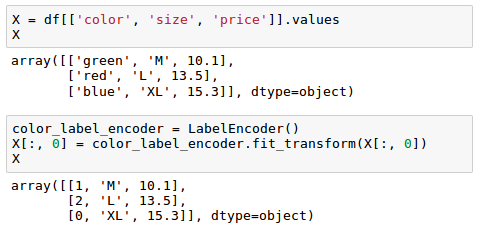



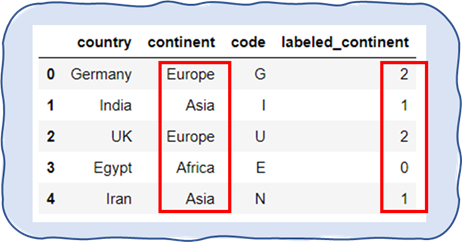


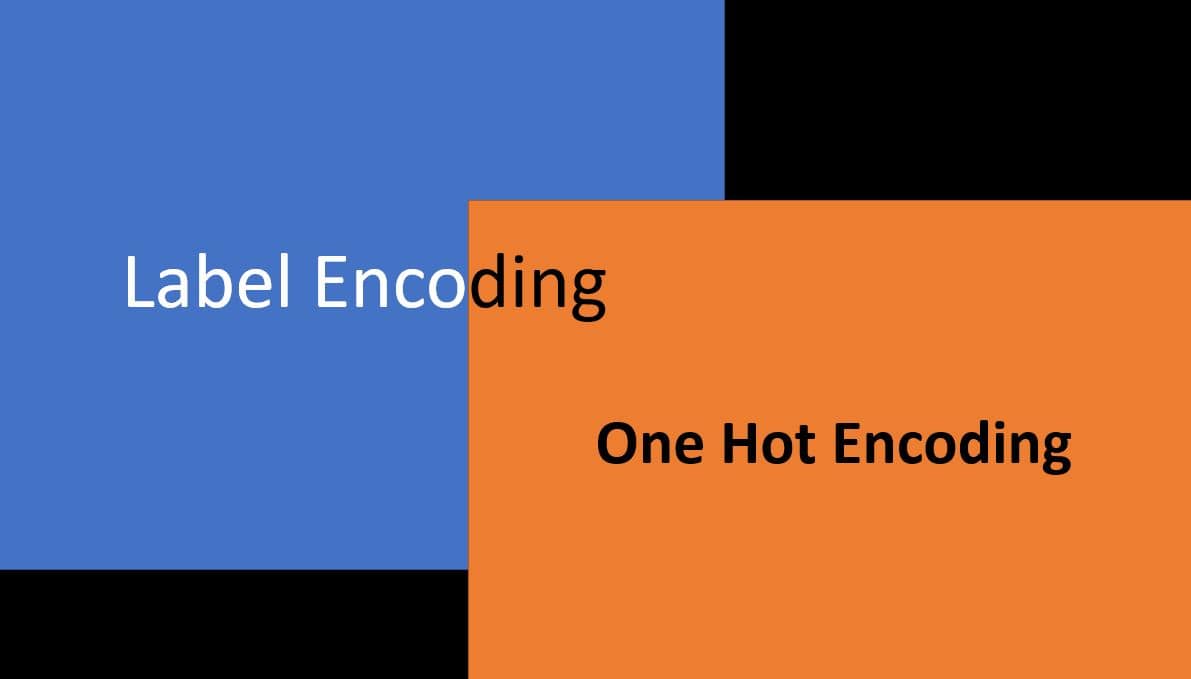







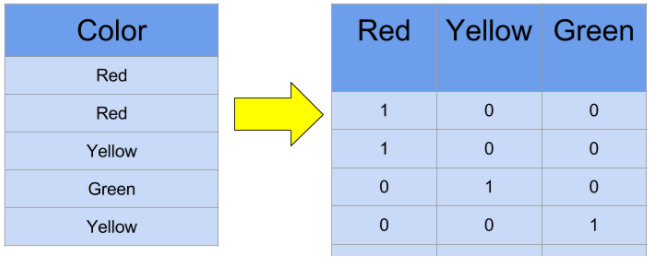
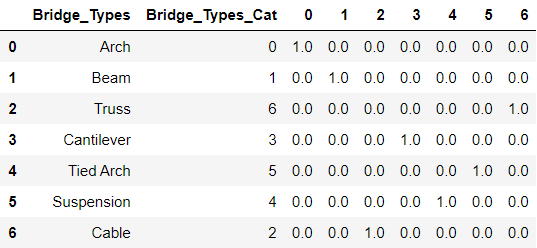
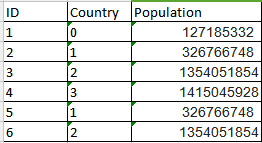

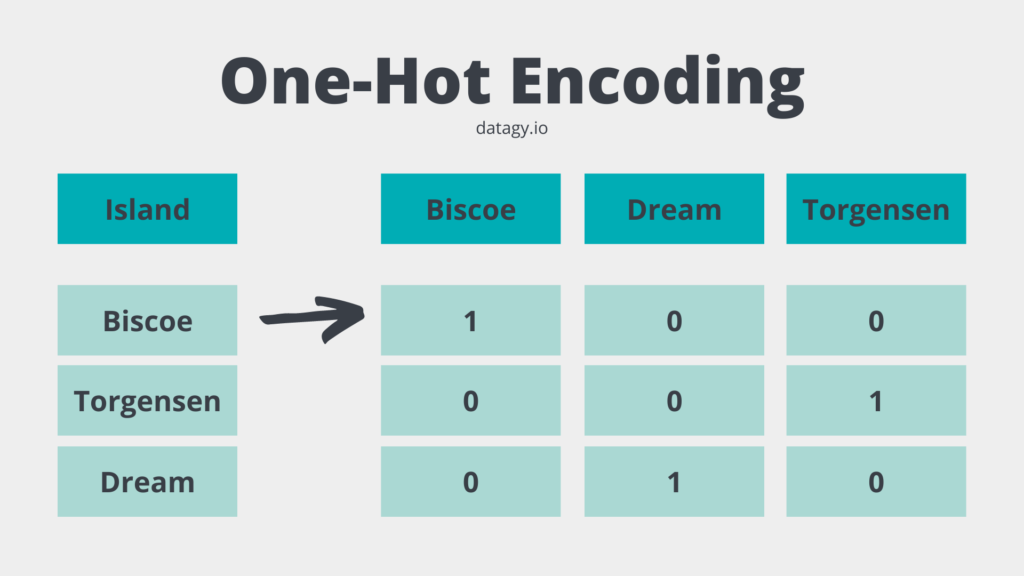
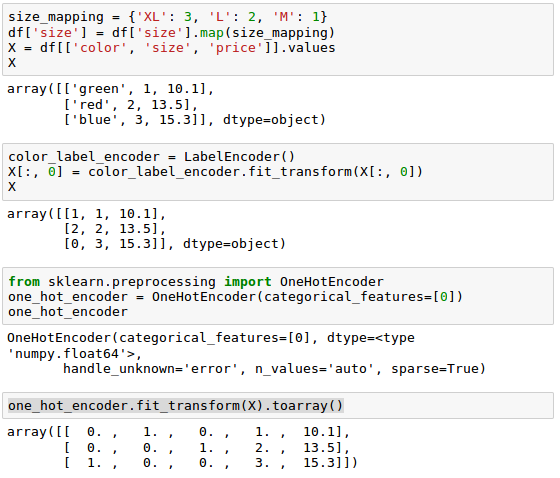
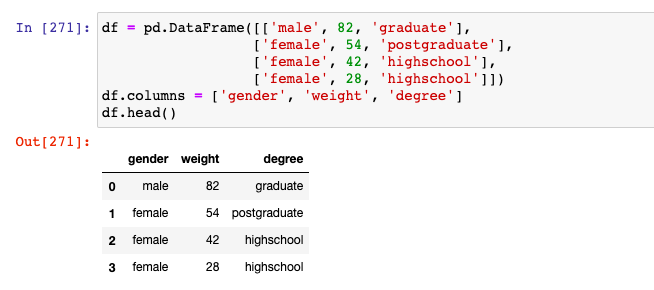



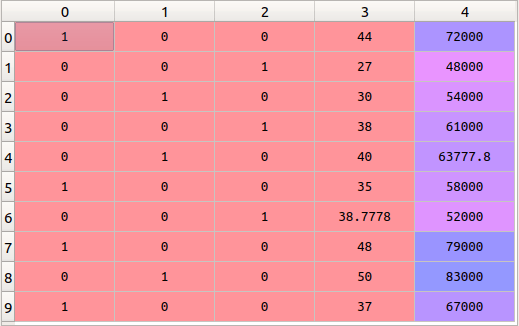
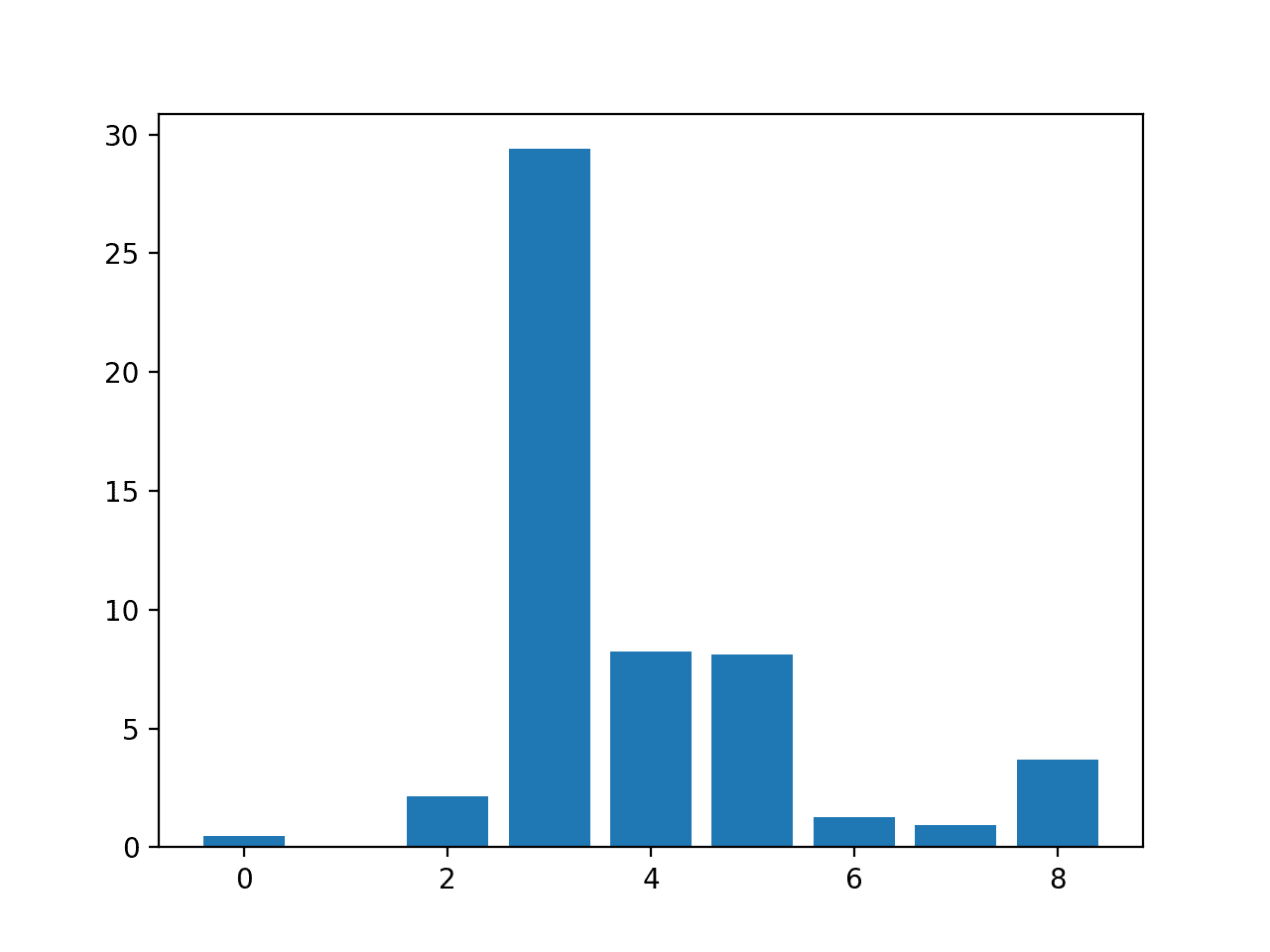

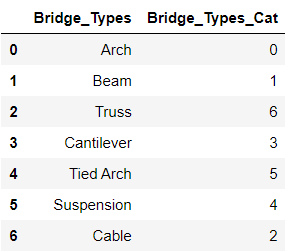




Post a Comment for "40 label encoder python example"